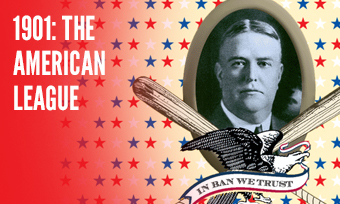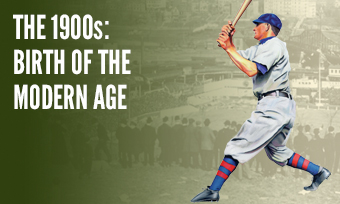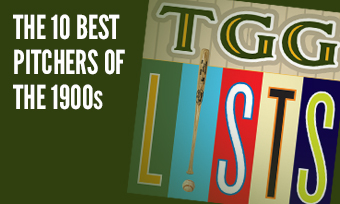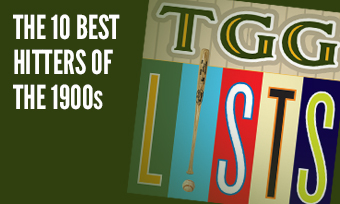The Yearly Reader
Leaders and Honors, 1901
Our list of baseball’s top 10 hitters and pitchers in both the American League and National League for the 1901 baseball season, as well as the awards and honors given to the game’s top achievers of the year.
The National League’s Top 10 Hitters, 1901
Bold type in brick red indicates league leader.
1. Honus Wagner, Pittsburgh
Key Numbers: .353 average, 101 runs, 201 hits, 37 doubles, 11 triples, 6 home runs, 126 RBIs, 49 stolen bases.
In one of the few years of the decade in which he didn’t win a batting title, Wagner still excelled at an elite level, setting a career high with 126 RBIs.
2. Jimmy Sheckard, Brooklyn
Key Numbers: .354 average, 116 runs, 19 triples, 11 home runs, 104 RBIs, .534 slugging percentage.
The young (age 22) outfielder proved the Superbas wrong for placing him second on the depth chart behind Fielder Jones the year before.
3. Ed Delahanty, Philadelphia
Key Numbers: .354 average, 106 runs, 38 doubles, 8 home runs, 108 RBIs.
In his last of 11 seasons before jumping to the American League—and reportedly helping others jump as well—Delahanty still possessed a wicked bat at age 33.
4. Jesse Burkett, St. Louis
Key Numbers: .376 average, 142 runs, 226 hits, 10 home runs, 75 RBIs.
Burkett played as if he was selling himself to the highest bidder—and that would come with the crosstown St. Louis Browns a year later.
5. Elmer Flick, Philadelphia
Key Numbers: .333 average, 112 runs, 32 doubles, 17 triples, 8 home runs, 88 RBIs.
Like Delahanty above, Flick also was ready to scram from the Phillies—though he made the mistake of staying within state lines (moving to the A’s) and within the jurisdiction of courts who would eventually order him back to the Phillies.
6. Sam Crawford, Cincinnati
Key Numbers: .330 average, 16 home runs, 104 RBIs.
Barely 21, Crawford exploded into stardom at Cincinnati following two years of monotone output; his 16 homers represented the highest season total by any major leaguer during the 1900s.
7. Topsy Hartsel, Chicago
Key Numbers: .335 average, 111 runs, 74 walks, 41 stolen bases.
After bouncing around the NL for three years, Hartsel finally found a full-time taker with the Orphans (Cubs).
8. Tom Daly, Brooklyn
Key Numbers: .315 average, 38 doubles, 90 RBIs.
The 35-year-old veteran finally logged his first season of 500+ at-bats and made them count, easily setting career highs in doubles and RBIs before fading out with the White Sox over the next two years.
9. Fred Clarke, Pittsburgh
Key Numbers: .324 average, 118 runs, 15 triples, 6 home runs, 60 RBIs.
In his second year as Pirates skipper-outfielder, Clarke nabbed his first of four pennants and led by example at the plate.
10. Ginger Beaumont, Pittsburgh
Key Numbers: .332 average, 120 runs, 8 home runs, 72 RBIs, 36 stolen bases.
His slight sophomore slide behind him, the swift, red-haired Beaumont put it into overdrive for the Bucs.
The American League’s Top 10 Hitters, 1901
1. Nap Lajoie, Philadelphia
Key Numbers: .426 average, 145 runs, 232 hits, 48 doubles, 14 triples, 14 home runs, 125 RBIs.
Until (and after) Babe Ruth came along and threw the record book on its head, Lajoie’s über-dominant campaign arguably ranks as the greatest, even if it was done against fledgling AL competition.
2. Buck Freeman, Boston
Key Numbers: .339 average, 88 runs, 15 triples, 12 home runs, 114 RBIs.
Two years after his 25 home runs nearly tied a then-major league record, Freeman qualified as a premier AL slugger by homering in double figures.
3. Jimmy Williams, Baltimore
Key Numbers: .317 average, 113 runs, 21 triples, 7 home runs, 96 RBIs.
A young rising star for the Pirates, Williams was all but kidnapped off the train to Pittsburgh spring camp by Baltimore manager John McGraw, who offered him a better baseball life with the Orioles.
4. Jimmy Collins, Boston
Key Numbers: .332 average, 108 runs, 42 doubles, 16 triples, 6 home runs, 94 RBIs.
Same city, different team, same results for the ex-Beaneaters (Braves) star.
5. Mike Donlin, Baltimore
Key Numbers: 121 games, .340 average, 107 runs 5 home runs, 67 RBIs, 33 stolen bases.
The talented but volatile hitting prodigy excelled in his first year at the major league level, delivering for the doomed Orioles.
6. John Anderson, Milwaukee
Key Numbers: .330 average, 190 hits, 46 doubles, 8 home runs, 99 RBIs.
The Norway-born Anderson put on a marvelous hitting exhibition during Milwaukee’s lone year at the major league level before the Braves parked there 50 years later; his 11 games with multiple doubles still represent an AL record.
7. Bill Keister, Baltimore
Key Numbers: 115 games, .328 average, 21 triples, 93 RBIs, 24 stolen bases.
The Orioles loved Keister’s hitting but held their breath whenever a ball came his way at shortstop; he committed 97 errors at the position.
8. Socks Seybold, Philadelphia
Key Numbers: .334 average, 8 home runs, 90 RBIs.
One of the few players who welcomed expanded major league employment with the birth of the AL, Seybold became a mainstay for the A’s after being buried in the minors in 1900.
9. Fielder Jones, Chicago
Key Numbers: .311 average, 120 runs, 84 walks, 38 stolen bases.
Playing as a charter member of the White Sox three years before becoming their manager, Jones hit over .300 for the second of three straight years and hiked his on-base percentage to an impressive .412.
10. Lave Cross, Philadelphia
Key Numbers: .328 average, 82 runs, 28 doubles, 12 triples, 73 RBIs, 23 stolen bases.
Cross returned to Philadelphia after spending much of the 1890s racking up solid numbers for the Phillies, and at 35 gave the A’s a vintage effort.
The National League’s Top 10 Pitchers, 1901
1. Deacon Phillippe, Pittsburgh
Key Numbers: 2.22 ERA, 22 wins, 12 losses, 296 innings.
Solid if not superlative numbers for the time, Phillippe still managed to represent the NL’s best pitching package for the moment.
2. Al Orth, Philadelphia
Key Numbers: 2.27 ERA, 20 wins, 12 losses, 6 shutouts, 281.2 innings.
The stingiest of three Phillies pitchers with exactly 20 wins on the year, Orth also led the NL in shutouts.
3. Noodles Hahn, Cincinnati
Key Numbers: 2.71 ERA, 22 wins, 19 losses, 375.1 innings.
Hahn became the Reds’ workhorse because he had to; almost no one else on the staff produced an ERA below 4.00, and that’s bad news in an era named after a lifeless ball.
4. Jack Chesbro, Pittsburgh
Key Numbers: 2.38 ERA, 21 wins, 10 losses, 6 shutouts, .677 win percentage, 287.2 innings.
By joining Phillippe with over 20 wins (and tying Orth with six shutouts), Chesbro flourished full flower in a career that would peak three years later with a superhuman effort.
5. Christy Mathewson, New York
Key Numbers: 2.41 ERA, 20 wins, 17 losses, 336 innings.
Though the AL stole most of the headlines in its inaugural campaign, the breakout effort from the 20-year-old Mathewson captured what little attention was left over for the NL.
6. Wild Bill Donovan, Brooklyn
Key Numbers: 2.77 ERA, 25 wins, 15 losses, 45 appearances, 351 innings.
After winning just one game over each of his previous three seasons, Donovan developed something else in common with the number one: He was number one in NL victories.
7. Vic Willis, Boston
Key Numbers: 2.36 ERA, 20 wins, 17 losses, 305.1 innings.
Willis found wins increasingly tough to come by as the Beaneaters sank deep in the standings for the long haul, but he managed to keep the victories ahead of pace with the losses for one of the few times while at Boston.
8. Red Donahue, Philadelphia
Key Numbers: 2.60 ERA, 21 wins, 13 losses, 304.1 innings.
Four years after giving up 306 runs in one season for St. Louis, Donahue welcomed the Deadball Era with open arms and produced his best ERA yet.
9. Jesse Tannehill, Pittsburgh
Key Numbers: 2.18 ERA, 18 wins 10 losses.
A relative lack of offensive support is the reason Tannehill, who delivered the lone ERA crown of his career, didn’t win 20 games for the only time over a five-year stretch.
10. Jack Powell, St. Louis
Key Numbers: 3.54 ERA, 19 wins, 19 losses, 45 appearances, 338.1 innings.
Before splitting across town to join the AL Browns, Powell gave the Cardinals one last tireless effort—but remained susceptible to the gopher ball, leading his league in allowing home runs (14) for one of four times in his career.
The American League’s Top 10 Pitchers, 1901
1. Cy Young, Boston
Key Numbers: 1.62 ERA, 33 wins, 10 losses, 371.1 innings.
Young’s dominant AL debut led to the only ERA title he would gain in the junior circuit—and the second (and last) of his storied career.
2. Clark Griffith, Chicago
Key Numbers: 2.67 ERA, 24 wins, 7 losses, .774 win percentage.
In securing his seventh (and last) 20-win campaign before focusing more on managing and, later, ownership, Griffith was greatly aided by teammates who supported him with over seven runs per start.
3. Roscoe Miller, Detroit
Key Numbers: 2.95 ERA, 23 wins, 13 losses, 332 innings.
Miller’s solid debut with Detroit would make him a one-year wonder; he would be 16-32 over the next three years before exiting the major league scene at 27.
4. Nixey Callahan, Chicago
Key Numbers: 2.42 ERA, 15 wins, 8 losses.
Callahan might have joined Griffith as a fellow 20-game winner for the White Sox, but a broken arm kept him out of action in the season’s first month.
5. Joe McGinnity, Baltimore
Key Numbers: 3.56 ERA, 26 wins, 20 losses, 48 appearances, 43 starts, 382 innings.
McGinnity brought his workhorse ethic to the AL in the first of two tumultuous years with the ill-fated Orioles.
6. George Winter, Boston
Key Numbers: 2.80 ERA, 16 wins, 12 losses.
The young right-hander would manage to hang in Boston for the bulk of the decade, but he could never duplicate these numbers.
7. Joe Yeager, Detroit
Key Numbers: 2.61 ERA, 12 wins, 11 losses.
The Tigers greatly benefitted from flash-in-the-pan pitchers; like Roscoe Miller above, Yeager’s inaugural output would be followed over the next two seasons by a 6-13 record and 4.77 ERA before he exited the majors for good.
8. Roy Patterson, Chicago
Key Numbers: 3.37 ERA, 20 wins, 16 losses, 312.1 innings.
Like Miller and Yeager above, Patterson’s star would also fall after a terrific first shot at it in Chicago—but unlike the others, his fade would be more gradual and not without additional honor.
9. Eddie Plank, Philadelphia
Key Numbers: 3.31 ERA, 17 wins, 13 losses.
While many pitchers on this list thrived (than died) as the AL’s shaky level of overall talent solidified, Plank—who came straight from Gettysburg College—proved he was the real deal and began his run as the AL’s all-time winning southpaw.
10. Chick Fraser, Philadelphia
Key Numbers: 3.81 ERA, 22 wins, 16 losses, 331 innings, 32 hit-by-pitches.
Workhorse effort for the right-hander during his one and only season in wonderland, before being brought back to reality when the courts ordered his return to the woebegone Phillies in 1902.









